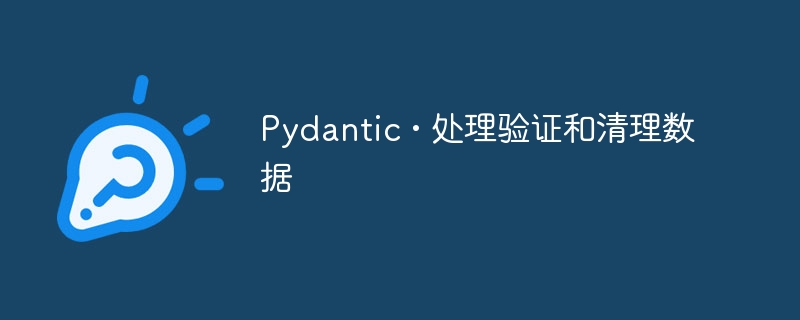Pydantic • 处理验证和清理数据
来源:dev.to
时间:2024-08-17 21:30:55 157浏览 收藏
从现在开始,我们要努力学习啦!今天我给大家带来《Pydantic • 处理验证和清理数据》,感兴趣的朋友请继续看下去吧!下文中的内容我们主要会涉及到等等知识点,如果在阅读本文过程中有遇到不清楚的地方,欢迎留言呀!我们一起讨论,一起学习!

自从我开始编程以来,我主要使用结构化和过程范例,因为我的任务需要更实用和直接的解决方案。在处理数据提取时,我必须转向新的范式才能实现更有组织的代码。
这种必要性的一个例子是在抓取任务期间,当我需要捕获最初属于我知道如何处理的类型的特定数据时,但突然间,它在捕获过程中要么不存在,要么以不同的类型出现。
因此,我不得不添加一些 if's 和 try 和 catch 块来检查数据是 int 还是 string ...后来发现什么都没有捕获,没有等等。有了字典,我最终保存了在以下情况下一些无趣的“默认数据”:
data.get(values, 0)
好吧,令人困惑的错误消息肯定不能再出现了。
这就是python 的动态性。变量可以随时更改其类型,直到您需要更清楚地了解正在使用的类型为止。然后突然出现一堆信息,现在我正在阅读如何处理数据验证,ide 可以帮助我处理类型提示和有趣的 pydantic 库。
现在,在数据操作等任务中,使用新范例,我可以拥有显式声明其类型的对象,以及允许验证这些类型的库。如果出现问题,通过查看更好描述的错误信息来调试会更容易。
派丹提克
所以,这是 pydantic 文档。有更多问题,咨询一下总是好的。
基本上,正如我们所知,我们从以下开始:
pip install pydantic
然后,假设我们想要从包含这些电子邮件的源中捕获电子邮件,其中大多数看起来像这样:“xxxx@xxxx.com”。但有时,它可能是这样的:“xxxx@”或“xxxx”。我们对应该捕获的电子邮件格式毫无疑问,因此我们将使用 pydantic 验证此电子邮件字符串:
from pydantic import basemodel, emailstr
class consumer(basemodel):
email: emailstr
account_id: int
consumer = consumer(email="teste@teste", account_id=12345)
print(consumer)
请注意,我使用了可选依赖项“email-validator”,安装方式为:pip install pydantic[email]。正如我们所知,当您运行代码时,错误将是无效的电子邮件格式“teste@teste”:
traceback (most recent call last):
...
consumer = consumer(email="teste@teste", account_id=12345)
^^^^^^^^^^^^^^^^^^^^^^^^^^^^^^^^^^^^^^^^^^^^^^^
...: 1 validation error for consumer
email
value is not a valid email address: the part after the @-sign is not valid. it should have a period. [type=value_error, input_value='teste@teste', input_type=str]
使用可选依赖项来验证数据很有趣,就像创建我们自己的验证一样,pydantic 通过 field_validator 允许这样做。因此,我们知道 account_id 必须为正且大于零。如果不同,pydantic 警告存在异常(值错误)会很有趣。代码将是:
from pydantic import basemodel, emailstr, field_validator
class consumer(basemodel):
email: emailstr
account_id: int
@field_validator("account_id")
def validate_account_id(cls, value):
"""custom field validation"""
if value <= 0:
raise valueerror(f"account_id must be positive: {value}")
return value
consumer = consumer(email="teste@teste.com", account_id=0)
print(consumer)
$ python capture_emails.py
traceback (most recent call last):
...
consumer = consumer(email="teste@teste.com", account_id=0)
^^^^^^^^^^^^^^^^^^^^^^^^^^^^^^^^^^^^^^^^^^^^^^^
...: 1 validation error for consumer
account_id
value error, account_id must be positive: 0 [type=value_error, input_value=0, input_type=int]
for further information visit https://errors.pydantic.dev/2.8/v/value_error
现在,使用正确的值运行代码:
from pydantic import basemodel, emailstr, field_validator
class consumer(basemodel):
email: emailstr
account_id: int
@field_validator("account_id")
def validate_account_id(cls, value):
"""custom field validation"""
if value <= 0:
raise valueerror(f"account_id must be positive: {value}")
return value
consumer = consumer(email="teste@teste.com", account_id=12345)
print(consumer)
$ python capture_emails.py email='teste@teste.com' account_id=12345
对吗?!
我还阅读了一些有关本机“dataclasses”模块的内容,该模块更简单一些,并且与 pydantic 有一些相似之处。然而,pydantic 更适合处理需要验证的更复杂的数据模型。 dataclasses 原生包含在 python 中,而 pydantic 还没有——至少现在还没有。
以上就是《Pydantic • 处理验证和清理数据》的详细内容,更多关于的资料请关注golang学习网公众号!
-
501 收藏
-
501 收藏
-
501 收藏
-
501 收藏
-
501 收藏
-
484 收藏
-
214 收藏
-
283 收藏
-
249 收藏
-
112 收藏
-
322 收藏
-
330 收藏
-
283 收藏
-
341 收藏
-
374 收藏
-
253 收藏
-
326 收藏
-

- 前端进阶之JavaScript设计模式
- 设计模式是开发人员在软件开发过程中面临一般问题时的解决方案,代表了最佳的实践。本课程的主打内容包括JS常见设计模式以及具体应用场景,打造一站式知识长龙服务,适合有JS基础的同学学习。
- 立即学习 543次学习
-

- GO语言核心编程课程
- 本课程采用真实案例,全面具体可落地,从理论到实践,一步一步将GO核心编程技术、编程思想、底层实现融会贯通,使学习者贴近时代脉搏,做IT互联网时代的弄潮儿。
- 立即学习 516次学习
-

- 简单聊聊mysql8与网络通信
- 如有问题加微信:Le-studyg;在课程中,我们将首先介绍MySQL8的新特性,包括性能优化、安全增强、新数据类型等,帮助学生快速熟悉MySQL8的最新功能。接着,我们将深入解析MySQL的网络通信机制,包括协议、连接管理、数据传输等,让
- 立即学习 500次学习
-

- JavaScript正则表达式基础与实战
- 在任何一门编程语言中,正则表达式,都是一项重要的知识,它提供了高效的字符串匹配与捕获机制,可以极大的简化程序设计。
- 立即学习 487次学习
-

- 从零制作响应式网站—Grid布局
- 本系列教程将展示从零制作一个假想的网络科技公司官网,分为导航,轮播,关于我们,成功案例,服务流程,团队介绍,数据部分,公司动态,底部信息等内容区块。网站整体采用CSSGrid布局,支持响应式,有流畅过渡和展现动画。
- 立即学习 485次学习
